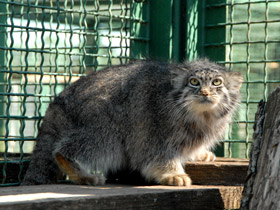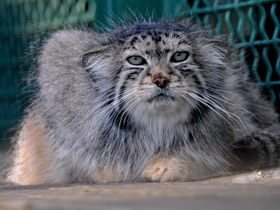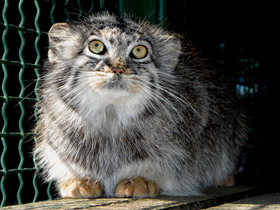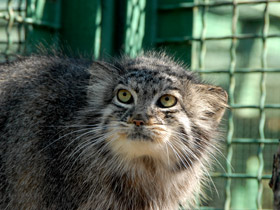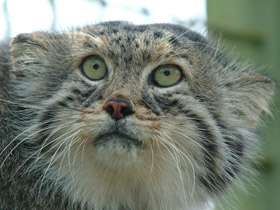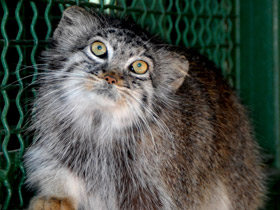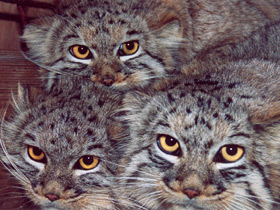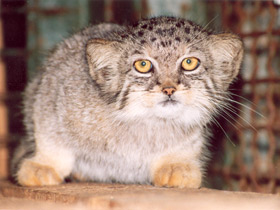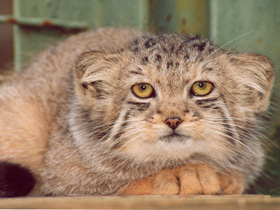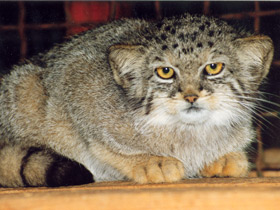El manul o el gato de Pallas (Otocolobus manul)
 The Pallas's cat or the manul (Otocolobus manul), listed on the Russian Red List
The Pallas's cat or the manul (Otocolobus manul), listed on the Russian Red List
The Pallas's cat or the manul (Otocolobus manul), also known as the manul, is a small wild cat with long and dense light grey fur, and rounded ears set low on the sides of the head.
Appearance
Otocolobus manul is a species of carnivorous mammal belonging to the family Felidae. Otocolobus manul is named after the German naturalist Peter Pallas, who discovered this species in the Caspian Sea in the 18th century.
In size, Otocolobus manul is comparable to the domestic cat (weighing 2.5-4.5 kg), but differs from it by its denser, more massive body on short, strong legs and very thick fur, which makes it appear much larger and thicker in winter than in other seasons (photo 1-6). The coat of Otocolobus manul is the densest among felines, with up to 9,000 hairs per square centimetre and reaching 7 cm in length. The tail of this remarkable cat is short and uniformly long with a precisely cut tip. What distinguishes Otocolobus manul is its relatively small, broad and flattened head, with small rounded ears, barely visible in the downy coat, short, blunt muzzle, large forehead and very large, yellow eyes. The expression on the muzzle of Otocolobus manul is always one of anger and discontent (photo 7-9).
Distribution and nutrition
Otocolobus manul inhabits steppe and semi-desert mountain areas with shrub thickets and stone placers. This small raptor feeds almost exclusively on pikes and rodents: gerbils, voles, gophers, gophers, hamsters, and also partridges and kokliks, occasionally catching tolai hares, young marmots, as well as larks and other small birds. When rodents are scarce, Otocolobus manul feeds on locusts, grasshoppers and other insects.
It catches its prey by hiding or carrying them near rocks; it can claw rodents out of shallow holes. In case of danger, Otocolobus manul often hides, cleverly camouflaging itself among rocks and dry grass.
Reproduction
The female burrows in rock crevices, in small caves, under stones or in old burrows of marmots, foxes or badgers. Gestation lasts about 60 days, 2 to 8 pups weighing 80 to 100 g are born; their colouring is noticeably dark spotted. They begin to see at 10-12 days, after sixteen weeks they are able to hunt independently, and at 6 months they are fully independent.
Otocolobus manul is rare throughout its range and numbers continue to decline. It is included in the Red List of the Russian Federation and in the IUCN Red List with the status of Near Threatened.
Taxonomy
Felis manul was the scientific name used by Peter Simon Pallas in 1776, who first described a Pallas's cat that he had encountered near the Dzhida River southeast of Lake Baikal. Several Pallas's cat zoological specimens were subsequently described:
- Felis nigripectus proposed by Brian Houghton Hodgson in 1842 was based on three specimens from Tibet.
- Otocolobus manul ferrugineus proposed by Sergey Ognev in 1928 was an erythristic specimen from the Kopet Dag mountains.
Otocolobus was proposed by Johann Friedrich von Brandt in 1842 as a generic name. Reginald Innes Pocock recognized the taxonomic rank of Otocolobus in 1907, described several Pallas's cat skulls in detail and considered the Pallas's cat an aberrant form of Felis.
In 1951, John Ellerman and Terence Morrison-Scott considered:
- the nominate subspecies Felis manul manul to be distributed from Russian Turkestan to Transbaikalia;
- Felis manul nigripecta to be distributed in Tibet and Kashmir;
- Felis manul ferruginea occurring from southwestern Turkestan and the Kopet Dag mountains to Afghanistan and Balochistan.
Since 2017, the Cat Classification Task Force of the Cat Specialist Group recognises only two subspecies as valid taxa, namely:
- Otocolobus manul manul syn. Otocolobus manul ferrugineus in the western and northern part of Central Asia from Iran to Mongolia;
- Otocolobus manul nigripectus in the Himalayas from Kashmir to Bhutan.
Threats
In China, Mongolia and Russia, the Pallas's cat was once hunted for its fur in large numbers of more than 10,000 skins annually. In China and the former Soviet Union, hunting of the Pallas's cat decreased in the 1970s when it became legally protected. Mongolia exported 9,185 skins in 1987, but international trade has ceased since 1988. However, domestic trade of its skins and body parts for medicinal purposes continues in the country, and it may be hunted throughout the year.
Cases of herding dogs killing Pallas's cats were reported in Iran, Kazakhstan and the Altai Republic. Pallas's cats have also fallen victim in traps set for small mammals in Kazakhstan and in the Altai Republic. In Transbaikal, the Pallas's cat is threatened by poaching. In Mongolia, the use of the rodenticide bromadiolone in the frame of rodent control measures in the early 21st century poisoned the prey base of carnivores and raptors. In the Sanjiangyuan region of the Tibetan Plateau, 54,147 km2 (20,906+1⁄4 sq mi) of grassland was poisoned between 2005 and 2009, leading to an estimated loss of 50,000–80,000 tonnes (55,000–88,000 short tons) of pika biomass. The Pallas's cat may be negatively affected by habitat fragmentation due to mining and infrastructure projects.
Conservation
On the IUCN Red List, the Pallas's cat is classified as Least Concern since 2020 because of its wide-spread range and assumed large global population. It is listed in CITES Appendix II. Hunting it is prohibited in all range countries except Mongolia. Since 2009, it is legally protected in Afghanistan, where all hunting and trade with its body parts is banned. On the Mongolian Red List of Mammals, it is listed as Near Threatened since 2006. In China, it is listed as Endangered. In Turkmenistan, it is proposed to be listed as Critically Endangered due to the scarcity of contemporary records.
In captivity
Between 1951 and 1979, the Beijing Zoo kept 16 Pallas's cats, but they lived for less than three years. In 1984, the Pallas's cat was designated as a priority species for captive breeding of the American Association of Zoos and Aquariums's Species Survival Plan. Almost half of the kittens born in member zoos died within the first 30 days, reaching the highest mortality rate in captivity of any small wild cat.
Zoos in the former Soviet Union received most of the wild-caught Pallas's cats from the Transbaikal region and a few from Mongolia. Moscow Zoo initiated a studbook for the Pallas's cat in 1997. Since 2004, the Pallas's cat international studbook has been managed by the Royal Zoological Society of Scotland, which also coordinates the captive breeding program for the Pallas's cat within the European Endangered Species Programme. As of 2018, 177 Pallas's cats were kept in 60 zoos in Europe, Russia, North America and Japan.
In 2011, a female Pallas's cat was artificially inseminated for the first time with semen from the male at the Cincinnati Zoo. After 69 days, she gave birth to four kittens, of which one was stillborn.
Etymology
'Manul' is the Pallas's cat's name in the Kyrgyz language. It is called 'manol' in the Mongolian language. The common name 'Pallas's cat' was coined by William Thomas Blanford in honour of Peter Simon Pallas.
In popular culture
The Pallas's cat is featured in a Russian Internet meme known as "Pet the cat" introduced in 2008. It is typically an image macro with a picture of an unfriendly and stern-looking Pallas's cat accompanied by a caption in which the cat invites the reader to pet it. In 2012, the Pallas's cat overwhelmingly won an online vote to become the Moscow Zoo mascot.










